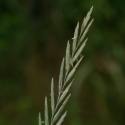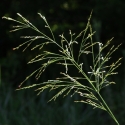
|
|
NATURE SEARCH HOME | PLANTS | GRASSES Don't miss these
GRASSES
Grasses share many features with the grass-like plants known as sedges. Unlike the sedges, the flowering stems of grasses are round and hollow in the center and the stems are interrupted at intervals by swollen areas known as nodes or joints. There are also differences in the leaf structure. Leaves are made up of two parts, the blade and a less obvious portion which wraps around the stem called the sheath. In grasses, the sheaths are usually split, or divided, at the top where they join the stem, a feature known as an open or partially open sheath. In contrast, sedge sheaths are closed or undivided. Grasses also share features with another group of grass-like plants known as rushes including round stems. Unlike the rushes, the grasses have hollow stems with joints. A basic understanding of the components of the flower cluster or Inflorescence is helpful for grass identification. The flower cluster is made up of a number of subdivisions called spikelets. A typical spikelet has two modified bracts called glumes at its base. Above the glumes are one to many florets or flowers. For example, Porcupine Grass (Hesperostipa spartea) has a simple spikelet with only a single flower enclosed by the glumes (see Photos B & C in the species description) while Japanese Brome (Bromus japonicus) (Photo E) and Stinkgrass (Eragrostis cilianensis) (Photos E & F) have a complex spikelet with many flowers enclosed by one set of glumes. In addition, each individual flower has its own covering made up of two bracts called the palea and lemma which enclose the reproductive parts, the anthers (usually 3), the two feathery stigmas and ultimately the seed. (See Porcupine Grass (Hesperostipa spartea) discussion and photos B & C and Black-seed Ricegrass (Piptatherum racemosum) discussion and photos G & H) Glumes, lemmas or paleas may have bristle-like extensions called awns as in Black-seed Ricegrass (photo G).
Disclaimer: The content of NatureSearch is provided by dedicated volunteer Naturalists of Fontenelle Nature Association who strive to provide the most accurate information available. Contributors of the images retain their copyrights. The point of contact for this page is: Neal Ratzlaff. |
||
|

